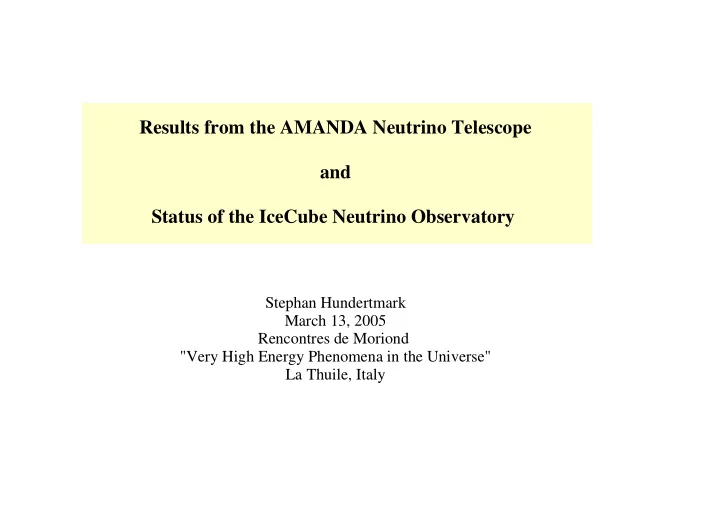

Results from the AMANDA Neutrino Telescope and Status of the IceCube Neutrino Observatory Stephan Hundertmark March 13, 2005 Rencontres de Moriond "Very High Energy Phenomena in the Universe" La Thuile, Italy
The AMANDA-II Detector 19 Strings 677 Optical Modules ~200 m diameter ~500 m height completed in 2000 Inner part: B10 detector (1997) 10 strings 302 Optical Modules
High Energy Phenomena for Neutrino Telescopes Topological SuperNova Defects Remnants Gamma Ray GZK- SuperNova Bursters Neutrinos Explosions GeV PeV MeV TeV EeV Atmospheric Active Galactic Neutrinos Nuclei Dark Matter Magnetic Monopoles Candidates (WIMPs)
Classification of Signals in AMANDA Diffuse, steady: Integrated flux from many sources (strongest flux) Signal exceeds background above a certain energy No individual sources are identified AGN, GRB, TD All flavor search Point source, steady: Identification of individual sources (weak flux) All sky search, or candidate catalog AGN, Muon channel only (pointing required) SuperNova Remnants, Galactic Sources Point source, transient: Search in coincidence with detected phenomena Time and space correlation reduces background GRB, Flary Sources dramatically
AMANDAs Field of View downgoing atmospheric muons EeV EeV UHE analysis solar WIMPs PeV PeV searches for Point Source diffuse neutrino searches GeV GeV fluxes atmospheric neutrinos Earth WIMPs
Scattering Natural Ice as Detection Medium Detailed knowledge of measured ice properties Modelling in the Simulation dN dt dRho (pe,t) Rel. Depth (m) Absorption Rho (m)
Atmospheric Neutrinos -- The Test Beam First measurement of the atm. ν µ 's flux above TeV About 600 selected up-going ν µ events (year 2000) Volkova Energy loss prop. to parametrization the muon energy → Volkova Energy determination parametrization via neural network and unfolding Preliminary PRELIMINARY Preliminary Spectral index ~ -2.7 Agreement with Frejus measurement
A Limit from the Atmospheric Neutrino Measurment Muon Neutrino Flux Set limit on cosmic neutrino flux: Maximum E -2 Volkova How much signal following E -2 contribution parametrization is allowed within the uncertainty of the highest energy bin ? Preliminary PRELIMINARY E 2 φ νµ ( 63TeV<E<2.5PeV ) < 2.6·10 -7 GeV cm -2 s -1 sr -1
UHE Analysis in AMANDA At > PeV huge muon range Large energy depositions ⇓ very bright events Earth opaque ⇒ Signal concentrated at horizon MC 2.6·10 19 eV MC 4.4·10 18 eV Experiment
UHE Analysis in AMANDA Extensive Investigation of Astroparticle Physics 22 (2005) 339-353 systematic uncertainties. (Ice properties, CR primaries, Muon propagation...) Background simulation describes data on all stages Analysing 1997 data: N bgr = 4.6 (±1.2) events N exp = 5 events prel. Sensitivity Current analysis with A-II (2000)
Overview Diffuse Searches AMANDA: 1) upward muons (1997) 2) upward muons (2000) 3) Cascades (2000) 6 4) UHE (1997) 6) UHE sensitivity (2000) Baikal: 5) Cascades (1998-2003)
Steady Point Source Search The Sky-plot (live-time 807 days, 00-03): 3329 neutrino candidates (up-going) 3438 expected from simulations < 5% misreconsructed down-going events No significant clustering observed Consistent with atm. neutrinos Search for excess of events compared to background for selected sources the full northern sky, (binned/unbinned method)
Steady Point Source Search Search for excess events from the direction of known γ -ray emitters Candidate z Luminosity N observed N back distance Source 1ES 0.047 219 Mpc 5 3.71 1959+650 TeV Blazars Markarian 0.03 140 Mpc 6 5.58 421 QSO 1.8 14000 Mpc 4 5.58 1633+382 GeV Blazars QSO 0.44 2600 Mpc 4 4.31 0219+428 Supernova CRAB 1.9 kpc 10 5.36 Remnant ⇒ No statistically significant excess from 33 objects
Building a Neutrino Observatory -- IceCube 80 strings with 60 optical modules each 4800 OMs Detector volume 1km 3 - Sensitivity well below Waxman-Bahcall bound Optimised for TeV-PeV neutrinos - 17m OM spacing - 125m interstring spacing Surface Array (IceTop) Build up finished by 2010
UHE in IceCube Simulations with AMANDA-B10 and IceCube
IceCube Sensitivity 12-16 strings will be deployed per year IceCube integrates AMANDA and data analysis will use the growing detector 7) Sensitivity for one year ν µ only
Summary AMANDA has searched the sky for high energy neutrinos. So far no source or no diffuse flux of high energy extraterrestrial neutrinos has been identified. Significant limits have been set, more analyses are under way IceCubes first string with 60 OMs was deployed in January 2005 IceCube will significantly increase All OMs communicate the sensitivity and deliver data as expected
title here
Searching for Time Variable Point Sources The 1ES1959+650 Case No statistical significant excess in the time correlation analysis was found i.e. 5 events on a background of 3.71 within a window of 40 days A-posteriori investigation: 3 of 5 events are within 66 days partly coverd by a multi-wavelength campain (May 2002) AMANDA events Due to the analysis setup and as blindness was violated, a probability for a random coincidence can not be quoted
Recommend
More recommend